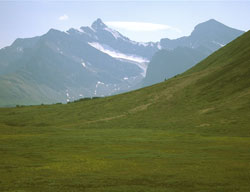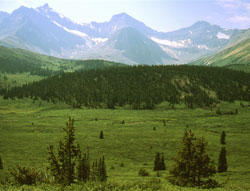
Photo: Looking south to Mount Southesk from Southesk (Cairn) Pass (courtesy Don Beers)
Mount Southesk
- 3125 m (10,253ft)
Located in the Southesk River Valley, south of Cairn River
Province: Alberta
Park: Jasper
Headwater: Saskatchewan
James Carnegie (Earl of Southesk) (The Ninth Earl of Southesk) travelled to Canada in 1859, thinking that it would improve his deteriorating health. He travelled from the Athabasca Valley to the Bow via Southesk Pass and Pipestone Pass. In 1875 he wrote, "Saskatchewan and the Rocky Mountains" which described his travels. During his 1859 trip, The Earl of Southesk and his friends climbed Southesk Cairn and built a giant cairn on top that can still be seen today. He wrote in his journal, "I am the first European who has visited this valley, and if I might have the geographic honour of giving my name to some spot of earth, I should choose the mountain near which the two rivers rise." However he was concerned that the peak he had chosen near the source of the Medicine Tent and Southesk Rivers might be visible from another valley and already named. But no one could dispute the one that he had climbed so it carries the name Southesk Cairn Mountain. The mountain that was his first choice also carries his name as Mount Southesk. [Esther Fraser] JAMES CARNEGIE (THE NINTH EARL OF SOUTHESK) At the age of 32, the Earl travelled to Canada from his native Scotland in 1859, after being advised that it would improve his health that had deteriorated following the death of his wife. He wrote that the reason for his journey was to, "travel in some part of the world where good sport could be met with among the larger animals, and where, at the same time, I might recruit my health by an active open-air life in a healthy climate." The Earl travelled though the United States to St. Paul, Minnesota and crossed the prairies, hunting buffalo along the way. In September he began he travelled up the Athabasca River from Fort Edmonton and then following the McLeod River. He went up the Medicine Tent River, writing that he was now entering country that, "…no European had ever seen, where bears and wild sheep were certain to be abundant." They continued their journey over Southesk Pass, and down Job Creek and Coral Creek to the Kootenay Plains of the Saskatchewan River valley. Then the party rode up the Siffleur River, over Pipestone Pass, and down the Pipestone River valley to the Bow River. After camping below Cascade Mountain, they continued past the remains of Old Bow Fort and onto the plains. James Hector had travelled through Pipestone Pass (northbound) about one month prior to the Earl's party. It is truly remarkable that the two Scots, James Hector and James Carnegie, almost met each other on Pipestone Pass at a time when they were two of the very few Europeans travelling in the Canadian Rockies. Carnegie returned to England, and with his health improved, re-married and had eight children by his second wife. In 1875 he wrote, "Saskatchewan and the Rocky Mountains" which described his travels. Southesk Cairn Mountain, Mount Southesk, Southesk Lake, and Southesk Pass have been named in his honour. [Additional information: Mountain Heritage Magazine; Vol. 3, No.1; Spring 2000] See also: Mount La Grace, Mount Toma, and Mount McBeath that were named to honour others in the Earl's party. [Additional information: "The Canadian Rockies" by Esther Fraser; pg. 57]
